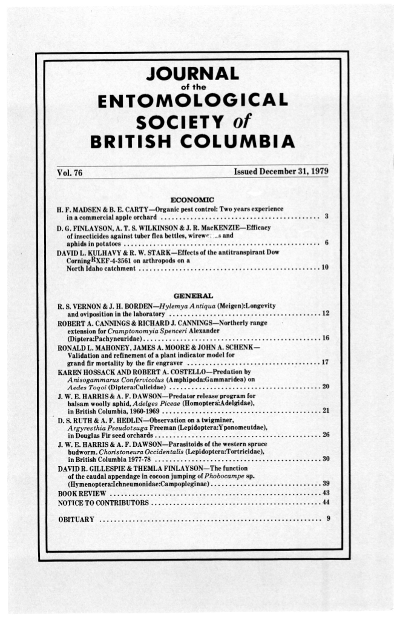The function of the caudal appendage in cocoon jumping of <i>Phobocampe</i> sp. (Hymenoptera: Ichneumonidae: Campopleginae)
Keywords:
<i>Phobocampe</i>, Hymenoptera, Ichneumonidae, CampopleginaeReferences
Clausen, C.P. 1940. Entomophagous Insects. McGraw-Hill, New York.
Finlayson, T. 1964. The caudal appendage of final-instar larvae of some Porizontinae (Hymenoptera: Ichneumonidae). Can. Ent. 96:1155-1158.
Fiske, W.F. 1903. A study of the parasites of the American tent caterpillar. Tech. Bull. New Hamps. Agric. Exp. Stn 6. pp. 185-230.
Hagen, K.S. 1964. Developmental stages of parasites. In Biological control of insect pests and weeds. Ed. by P. DeBach. Reinhold, New York. pp. 168-246.
Howard, L.O. and W.F. Fiske. 1911. The importation into the United States of the parasites of the gipsy moth and the brown-tail moth: a report of progress, with some consideration of previous concurrent efforts of this kind. Bull. Bur. Ent., U.S. Dept. Agric., No. 91.
Morley, C. 1914. Ichneumons of Great Britain. V. Ophioninae. H. and W. Brown, London.
Muesebeck, C.F.W. and D.L. Parker. 1933. Hyposoter disparis Viereck, an introduced ichneumonid parasite of the gipsy moth. J. Agric. Res. 46:335-347.
Thompson, W.R. and H.L. Parker. 1930. The morphology and biology of Eulimneria crassifemur an important parasite of the European corn borer. J. Agric. Res. 40:321-345.
Thorpe, W.H. 1932. Experiments upon respiration in the larvae of certain parasitic Hymenoptera. Proc. R. Soc. Lond. (B) 109:450-471.
Downloads
Published
Issue
Section
License
Authors who publish with the Journal of the Entomological Society of British Columbia agree to the following terms:
-Authors retain copyright and grant the journal right of first publication with the work simultaneously licensed under a Creative Commons Attribution License that allows others to share the work with an acknowledgement of the work's authorship and initial publication in this journal.
-Authors are able to enter into separate, additional contractual arrangements for the non-exclusive distribution of the journal's published version of the work (e.g., post it to an institutional repository or publish it in a book), with an acknowledgement of its initial publication in this journal.
-Authors are permitted and encouraged to post their work online (e.g., in institutional repositories or on their website) prior to and during the submission process, as it can lead to productive exchanges, as well as earlier and greater citation of published work (See The Effect of Open Access).


